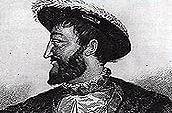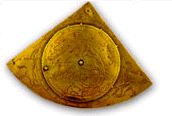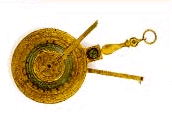The great explorations
Cartier-Brébeuf National Historic Site
 Engraving of François I
Engraving of François I© National Archives of Canada
Between 1534 and 1542, Jacques Cartier made three voyages to North America. The second expedition, which was carried out between 1535 and 1536, is notable for having identified a point of entry into the continent i.e., the St. Lawrence River. The event represents a turning point for the future development of the St. Lawrence Valley. The exploits of the navigator from Saint-Malo, France, who was commissioned by François I, are part of the great movement of European exploration which began at the end of the Middle Ages. It was a period of intense renewal occurring in a variety of spheres: population growth; economic transformations; an upswing in trade and commercial networks; improvement in monetary and credit mechanisms; the emergence of a middle class; the reinforced power of princes, who took a more prominent role among more solidly constituted governments; spiritual renewal borne by a current of humanism which, by fostering scientific curiosity, brought forth not only a new conception of the world but also improved navigational instruments. The combination of these various developments enabled a number of European monarchs in the 15th and 16th centuries to take to the seas with the intention of conquering new areas of the world.
Causes of expansion
 Brass quadrant. Quadrants were used by navigators to determine their latitude.
Brass quadrant. Quadrants were used by navigators to determine their latitude.© Musée Stewart at the Fort de l'Île Sainte-Hélène
The main causes for this expansion to the Americas are above all political, religious and economic in nature. Europeans, who had become accustomed to costly products from Asia and easy commerce with India, were forced to revise their purchasing strategies on account of the increasing menace represented by Islam. France feared it would be unable to extract itself from the numerous Italian and Arab middlemen it was dependent on. And, owing to the closely related problem of their trade deficit with the Orient, Europeans were obliged to seek out other supply locations, such as Africa or the Americas, in order to obtain the precious metals required to offset this imbalance.
America or Asia?
Against the backdrop of the great movement of explorations, contact with the New World stands out prominently. North America had probably already been reached by Celts from Ireland around 800 or 900 A.D. It was sighted once again by the Viking Bjarni in 986, and then visited sporadically thereafter from 1002 until the 14th century. By the first quarter of the 16th century, the northeast coast of North America was frequented by European fishermen Basques, Bretons and Portuguese for the most part.
However, these exploits went practically unnoticed at that time, as they did not constitute official voyages of exploration. Several years after Christopher Columbus reached the southernmost tip of North America (1492), which he believed was a part of Asia, a series of expeditions to the northeast portion of the continent were led by Giovanni Caboto (John Cabot), in 1497-1498. In addition to England, other countries Portugal, Spain and, following them, France all launched exploratory missions. Thus, following in the footsteps of his predecessors the Cabots, Corte-Real (1500-1502), Fagundes (1520), Gomez (1525), Rut (1527) and above all Verrazanno (1524), Jacques Cartier in turn set out to explore new lands.
Setting course for the northeast
 Brass astrolabe. Among other purposes, astrolabes were used to tell time at night.
Brass astrolabe. Among other purposes, astrolabes were used to tell time at night.© Musée Stewart at the Fort de l'Île Sainte-Hélène
The traditional focus of France's commercial relationships was the Mediterranean region. As, during the period concerned, France was also involved in a serious of ruinous wars, including those which pitted it against Italy, this country was relatively slow to embark in the movement of explorations i.e., close to 100 years after the Portuguese set out for the African coast. The Portuguese and the Spanish had, by that time, taken control of South and Central America, which in theory required the other European powers seeking new territory to concentrate their voyages outside of the circuits already occupied. The English and the French thus shifted their exploration efforts to the north-eastern portion of North America.
It is generally believed that the success of Magellan and Del Cano's expedition to the Indies (1519-1522) stimulated François I's desire to discover a shorter route to Asia, via a passage through the North American continent north of the areas claimed by Spanish explorers. In the pursuit of this objective, Verrazano unsuccessfully combed the American coastline in 1542. And, in keeping with this same objective, Jacques Cartier entered the St. Lawrence River some 10 years later.
- Date modified :